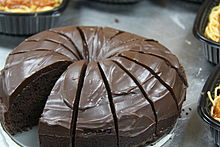Devil's food cake
 Devil's food cake with vanilla icing | |
| Type | Layer cake |
|---|---|
| Place of origin | United States |
| Main ingredients | Flour, butter (or a substitute), egg whites, cocoa solids |
| Variations | Red velvet cake |
Devil's food cake is a moist, airy, rich chocolate layer cake. It is considered a counterpart to the white or yellow angel food cake. Because of differing recipes and changing ingredient availability over the course of the twentieth century, it is difficult to precisely qualify what distinguishes devil's food from the more standard chocolate cake, though it traditionally has more chocolate than a regular chocolate cake, making it darker. The cake is usually paired with a rich chocolate frosting.
Overview
Devil's food cake is commonly a dense, rich chocolate cake, quite different from other chocolate cakes such as the German chocolate cake. It traditionally uses unsweetened chocolate baking squares in lieu of unsweetened cocoa powder. However, contemporary recipes typically use cocoa powder for its convenience over the more traditional chocolate baking squares. Also, because of its reduced amount of cocoa butter, cocoa powder has a more intense chocolate flavor than unsweetened chocolate.[1][2] Moreover, coffee is frequently added as a liquid to enhance the chocolate flavor.[3] Some recipes use hot or boiling water as the cake's main liquid, rather than milk. One of the more famous devil's food cake recipes, called "The Vassar Devil," was on the menu of the historic and now closed restaurant "The Treasure Chest." A competing recipe was the Wellesley Fudge Cake, which uses a half pound of unsweetened baking chocolate, four ounces for the cake itself and four ounces for the fudge frosting. Devil's food cake historically is baked as a layer cake. Its antithetical counterpart, the angel food cake, is a very light white cake that uses stiffly beaten egg whites and no dairy. However, the devil's food cake is most often paired with yellow vanilla cakes, and the two combined may create a marble cake.

Devil's food cake is sometimes distinguished from other chocolate cakes by the use of additional baking soda (sodium bicarbonate), which raises the pH level and makes the cake a deeper and darker mahogany color.[3] Devil's food cake incorporates butter (or a substitute), eggs, flour, and less egg than other chocolate cakes.[3] Devil's food cake was invented in the United States in the early twentieth century, with the recipe in print as early as 1905.[4]
A loosely related cake is the red velvet cake. This cake was invented at the Waldorf Astoria Hotel in New York City. It is very popular throughout the US, but is a particular favorite in the south. Most red velvet cakes today use red food coloring, but the unrelated addition of “red” to a chocolate cake’s name initially arose because of the chemical reaction of acid in unsweetened bar chocolate and natural (non-alkalized) cocoa powder in conjunction with an acidic liquid (generally buttermilk or sour milk) with an alkali (baking soda), which reveals the red anthocyanin, a water-soluble vacuolar pigment. (In contrast, chocolate cakes made with baking powder and a non-acidic liquid turn out blackish in color.) Near the beginning of the twentieth century, these chocolate cakes became known as “red cake,” “red regal cake,” “red feather [as in light-as-a-feather] cake,” “feather devil’s food cake,” and “red devil’s food cake.” However, their slightly reddish-dark brown hue was quite different from and much duller than food coloring-enhanced red velvet.[5]
See also
References
- ^ "Chocolate vs. Cocoa Powder". FineCooking.com. Retrieved 2015-09-29.
- ^ Sertich Velie, Marissa. "Can I Substitute Unsweetened Chocolate for Cocoa Powder?". SeriousEats.com. Retrieved 2015-09-29.
- ^ a b c Samuel A. Matz (1 January 1992). Bakery Technology and Engineering. Springer. pp. 344–345. ISBN 978-0-442-30855-1. Retrieved 15 April 2012.
- ^ Judith M. Fertig (13 September 2003). All-American Desserts: 400 Star-Spangled, Razzle-Dazzle Recipes for America's Best Loved Desserts. Harvard Common Press. pp. 144–. ISBN 978-1-55832-191-5. Retrieved 15 April 2012.
- ^ [1]
External links
![]() Media related to Devil's food cakes at Wikimedia Commons
Media related to Devil's food cakes at Wikimedia Commons
